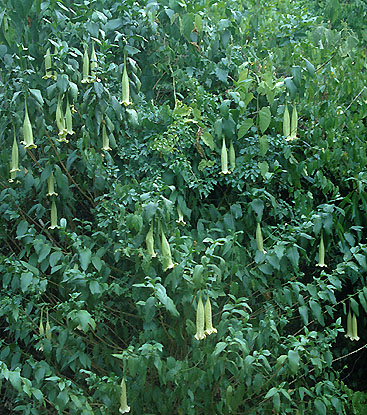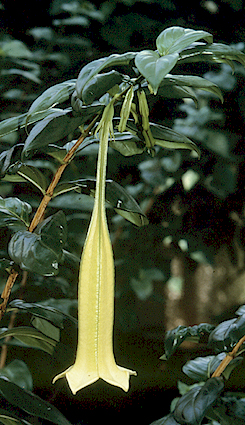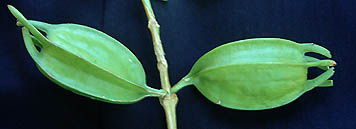Rubiaceae of the New World
By Piero Delprete and
Rocio Cortés
CUBANOLA Aiello
Rubiaceae of the New World
By Piero Delprete and
Rocio Cortés
CUBANOLA Aiello

Cubanola domingensis Habit (above) and fruits (below) Parque Nacional del Este Dominican Republic Photos P. Delprete |
 |
 |
Cubanola domingensis
Flower in anthesis (above) National Botanical Garden Santo Domingo, Dominican Republic Photo P. Maas |
Synonyms: Gonianthes A. Richard in Sagra (nomen), non Gonianthes Blume
Shrubs or small trees; raphides absent; axillary thorns absent. Stipules interpetiolar, connate at base, deltoid, acuminate, persistent. Leaves opposite, long- to short-petiolate; blades elliptic, obovate or oblong, chartaceous or thinly coriaceous; foliar pellucid glands absent; domatia absent. Inflorescence axillary, uniflorous. Flowers bisexual, protandrous. Calyx tube absent, lobes connate or free at base, persistent; lobes 5, narrowly lanceolate or linear; long. Calycophylls absent. Corolla narrowly infundibuliform, actinomorphic, white to cream-white; tube externally glabrous, internally glabrous, without a pubescent ring inside; orifice annular thickening absent; lobes 5, imbricate (tube reduplicate), broadly triangular, margin entire, rounded at apex. Stamens alternate to the corolla lobes, partially exserted (only tips exserted); anthers long-linear, round at base, round at apex, dehiscing by longitudinal slits, basifixed; filaments attached at base of the corolla tube, free at base, slender, long, shorter than corolla tube, equal, glabrous. Pollen colpate, apertures 3, exine surface echinate-perforate, released as monads. Style exserted just beyond the corolla, terete throughout, not fleshy; glabrous; lobes absent, stigmatic surface linear along style. Ovary inferior, 2-locular, obconical or turbinate; placentation axile, placenta peltate to the entire lenght of the septum, ovules many per locule. Fruit a septicidal and loculicidal capsule (both modes of dehiscence contemporaneous), thinly woody. Seeds horizontal, medium-sized, 3-5-angular, dorsoventrally compressed, elliptic to narrowly elliptic in outline; wings absent.
Geographic distribution: West Indies. Sometimes cultivated in Caribbean local gardens for its large, ornamental flowers.
Number of species: 2.
References: A. Aiello, A reexamination of Portlandia (Rubiaceae)
and associated taxa. J. Arnold Arb. 60: 38–123. 1979; E. Robbrecht &
D. M. Bridson, Nomenclatural notes on three Rubiaceae genera. Opera Bot.
Belg. 6: 197–200. "1993" [1994].